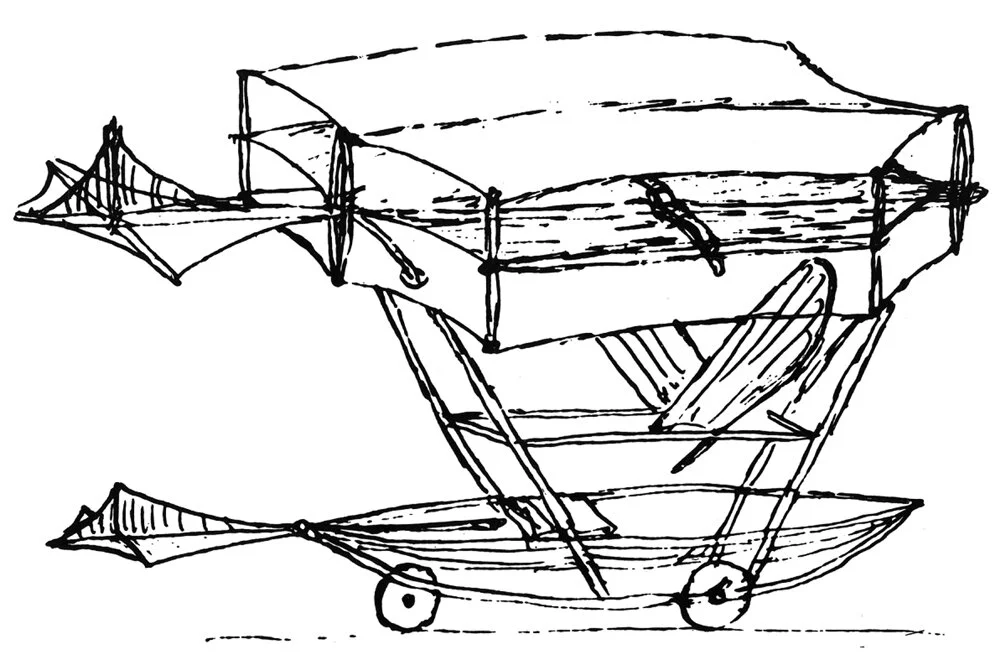Sir George Cayley and the Science of Aviation
Sir George Cayley’s 1849 triplane design. He briefly tested a prototype of this design, with limited success.
Sir George Cayley was an Englishman who is credited as the first person to understand the underlying principles of flight. He was born in Yorkshire, England in 1773, and from a young age he was fascinated with the idea of flight. Cayley was an engineer by trade, and his early engineering career involved many different fields. He shifted his focus to flight around 1850, and his scientific approach to the study of flight has led him to be called the world’s first aeronautical engineer.
Cayley’s studies in flight began much earlier than 1850, however. While he was still in school, he drew simple sketches of glider models in his school notebooks. The first, pictured below, is from 1804. It features a central spine with an inclined broad wing near the front, and a tail fin to provide stability. In many ways, its layout is the basis for modern aircraft design. Cayley built a model of this design, and he found success flying it.
Sir George Cayley’s glider designs. Top: original sketch from 1804 for a glider. Middle: a fixed-wing glider from 1849, improved from his original sketch. Bottom: an 1853 glider sketch, Cayley’s most advanced design.
Cayley studied the underlying principles of flight, and he’s credited with discovering the four basic vector forces that affect flight. The first is thrust, which acts in the direction of flight. In modern planes, thrust is created by a propeller or jet engine. The second is drag, which acts in opposition to thrust, pushing back on the aircraft, causing it to slow down. Drag is created by friction from the air or differences in air pressure. The third is lift, which pulls the aircraft upward and keeps the aircraft in flight. Lift is created by an aircraft’s wings. One of Cayley’s major advancements was his development of the airfoil, which is a cross-sectional shape that creates lift through air pressure differentials. The fourth and last force is weight, or gravity. Weight pulls the aircraft down, in opposition to lift. These four forces were studied by Cayley, and his understanding of them no doubt helped him to successfully test his glider designs.
There are two glider designs that Cayley is best known for. The first, pictured at the top of this post, is from 1849. It’s a tri-plane, which means it had three sets of wings. Apparently this glider design was successfully flown with a boy onboard. Details of this alleged flight have been lost to history, but his sketch remains as evidence of the craft’s design.
Sir George Cayley’s 1852 design for a glider. He tested the glider with a pilot, with limited success.
The second glider designed by Cayley is pictured above, from 1852. This craft featured a large kite-like wing at the top, with multiple steering and stabilizing elements at the rear. Suspended below the wing was a boat-like cockpit. Many of Cayley’s designs placed the center of gravity below the wings, which helped to stabilize the craft in flight, and the cockpit on this craft did just that. This glider design was built and successfully tested in 1853, with an adult aviator in the cockpit.
Sir George Cayley has been called the Father of Aviation. His scientific approach to the study of flight was crucial to the success of his gliders, and he’s had a profound influence on many ground-breaking inventors and aviators since. Wilbur Wright, of the Wright Brothers, was keenly aware of the influence of Cayley’s work, and he sums it up well:
About 100 years ago an Englishman, Sir George Cayley, carried the science of flying to a point which it had never reached before and which it scarcely reached again during the last century.[2]
Read more about other ideas for flying machines here.
[1]: Cayley, George. "On Aerial Navigation." Nicholson's Journal of Natural Philosophy (1809–1810).
[2]: Gibbs-Smith, C.H.. Sir George Cayley’s Aeronautics 1796-1855. London: HMSO, 1962.





